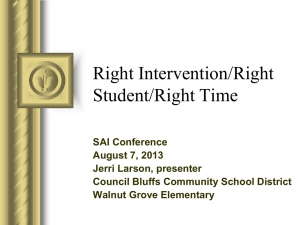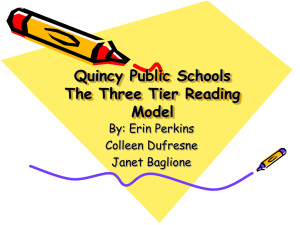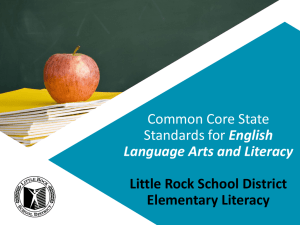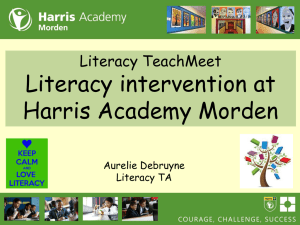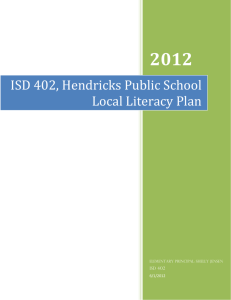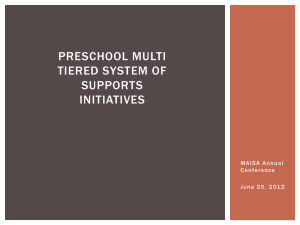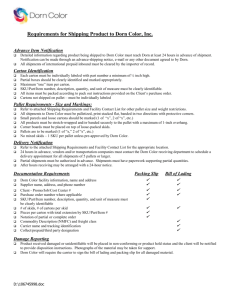The Comprehensive Intervention Model for Preventing Reading
advertisement
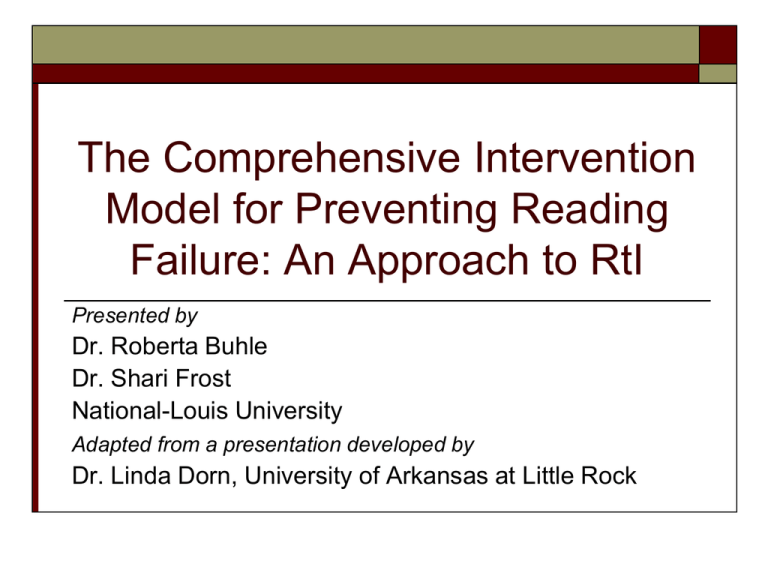
The Comprehensive Intervention Model for Preventing Reading Failure: An Approach to RtI Presented by Dr. Roberta Buhle Dr. Shari Frost National-Louis University Adapted from a presentation developed by Dr. Linda Dorn, University of Arkansas at Little Rock The Comprehensive Intervention Model Developed by Dr. Linda Dorn University of Arkansas at Little Rock Supported by a large body of research A 15 year track record of success Not a “box program” Responsive and differentiated instruction delivered by knowledgeable teachers Research on CIM Dorn,1992 Dorn, 1993 Paige, 1997 Harrison, 2002 James, 2005 Rahi, 2005 Platt, 2007 Dorn, 2007 Studies in process: Dorn & Soffos Dorn & Behrend Taylor, Gates, Wyatt, Jamison CIM: Part of the Partnership in Comprehensive Literacy Reading Recovery District Literacy Coaches Building Literacy Coaches Interventionists Network of Literacy Administrators Annual Literacy Conferences Ten Features of the Partnerships in Comprehensive Literacy Model 6. Framework for Literacy Coaching and Mentoring Model Classrooms High Standards Accountability System Interventions 7. Professional Learning Communities 8. Well-designed Literacy Plan Technology Spotlighting & Advocacy 1. 2. 3. 4. 5. 9. 10. Maintain Focus on System Goal Changing the achievement profile of an entire school by: Providing high quality interventions that increase literacy levels of low-performing students Professional development for teachers that increase knowledge and expertise in teaching the lowest performing students Collaboration among professionals Start with Informative Screenings To collect baseline data To identify strengths and weaknesses in instructional program To identify students in need of diagnostic testing and/or intervention To prepare a written plan of intervention, including predictions of progress Dynamic Interventions in a Layered 4-Tiered Approach Tiers 2 and 3 are not linear. They represent degrees of intensity for meeting student needs. Classroom Literacy Program Tier 1: Core classroom program with differentiated small group instruction CR Intervention Group/Individual Classroom teacher provides additional support to lowest group. Small Group Intervention or 1-1 Intervention Special Education Tier 2: Small group with intensity that relates to group size and expertise; duration in group depends on student need Tier 3: 1:1 with Reading Recovery in 1st grade; 1:2 group or reading/writing conferences in upper grades Tier 4: Referral process after student has received intervention in layers 1, 2, All interventions are dynamic and interactive, not static and linear. and 3 8 Classroom Interventions (Tier One) Reflective Practice Student Conferences (reading & writing) Smaller group which meets daily Assisted Writing Groups* Guided Reading Plus Groups* Comprehension Focus Groups* Emergent Language and Literacy Groups* Student Interventions (Tier Two) Early Interventions (K-3) Intervene as early as possible because confusions become habituated Will take less time (12-20 weeks) Upper Interventions (4-12) Habituated confusions, low motivation Will take more time to identify the confusions, break the unproductive habits, and redirect for greater productivity Types of Tier Two Groups Emergent Language and Literacy Assisted Writing Guided Reading Plus Writing Process Comprehension Focus Genre Strategy Content The Role of the Coach in Implementing CIM Coaching Activities Professional development Assessment support Facilitating the RtI team Serving as an interventionist Professional Development Maintaining a professional library Whole school professional development Grade level teams Study groups Book clubs Coaching cycles Assessment Support Training teachers Supporting teachers Assessment administration Managing assessments Creating data reports Creating and maintaining data walls (assessment and intervention walls) Assessment Wall Intervention Portfolios Summative and formative assessments are organized for instructional purposes and documentation. Facilitating the RtI Team Collaborate with the principal in identifying the members of the team Set norms for the team interaction Prepare agendas Prepare and present data for team analysis Keep focus on whole school improvement Facilitate disseminating team’s decisions Serve as an Interventionist Teach at least one intervention group Maintains credibility with teachers Makes you a part of the learning community Allows you to see firsthand how the interventions work Increase your knowledge and capacity by working students Real Results! Third Grade Fall Third Grade Winter First Grade Fall First Grade Winter Partnerships of Comprehensive Literacy University Training Centers University of Arkansas at Little Rock University of Maine St. Mary’s College University of Kentucky at Lexington Purdue University National-Louis University Print Resources Video Resources Coming in May, 2010
